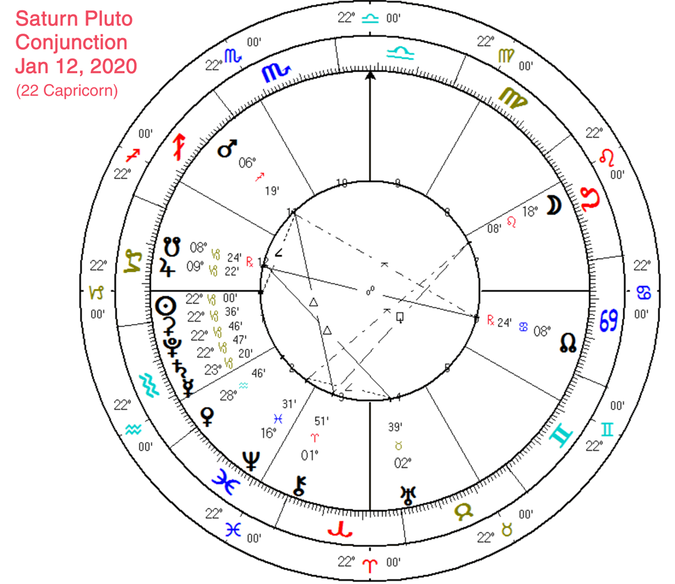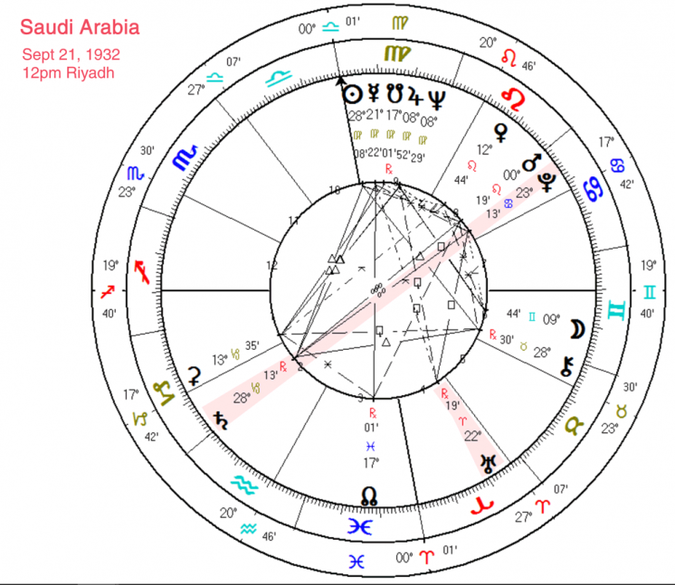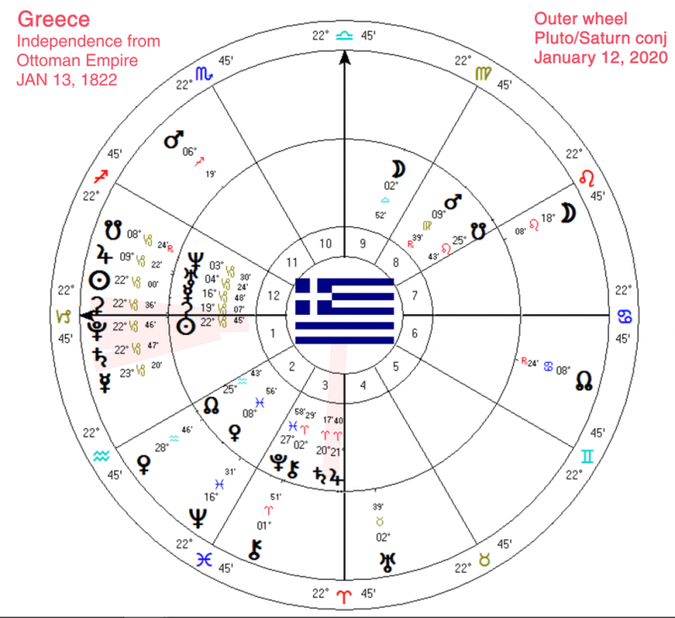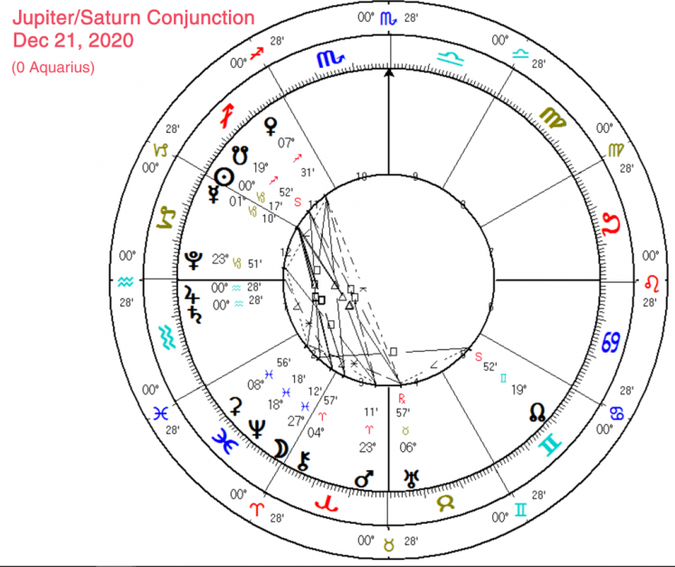The Powerful Astrological Cycles of 2020
The Saturn – Pluto Conjunction
And the Transits for the year 2020
(Published in the Dec 2015 edition of The Mountain Astrologer)
By Maurice Fernandez
The Saturn – Pluto Conjunction
And the Transits for the year 2020
(Published in the Dec 2015 edition of The Mountain Astrologer)
By Maurice Fernandez
|
In astrology, every moment matters. The cosmic clock ticking, as planets (and luminaries) pursue their motion and form celestial patterns, provides a flavor, a meaning, or a message for each passing minute or for a whole epoch. We ourselves are the embodiment of the moment of our birth; as such, each one of us represents a moment in time. In other words, each fraction of time has a purpose.
Watch a video about the years 2019-2020:
Click here to watch Video Read Article about Saturn/Pluto in each natal house: Click here to watch Video Astrologers track and interpret these passing transits. Some of them will definitely be more dramatic in effect than others. Particularly, when two or more planets form cardinal angles (0, 90, 180 degrees) to each other in the course of their cycle, prominent global developments are activated. The Current Times When slower-moving bodies form angles to one another, the effects can be even deeper and farther-reaching because these planets interlock for a longer period of time, and their contacts are much less frequent. For example, in the recent past, we have all experienced, and can share personal anecdotes about, the transiting Uranus–Pluto square, within orb since at least 2010 and still within range of influence in 2015. Both of these bodies represent a strong call for change, with Uranus prompting us to elevate our consciousness and refine our ways, and Pluto taking us on a descent into the crevasses of our emotional difficulties. The higher mind (Uranus) must be met with the emotional depths (Pluto) for change to occur in integrated ways, in both higher and lower realms. If such an integration is lacking, change may be destructive or ineffective. The Uranus–Pluto square instigated social change on a worldwide scale. The intensity of these influences has kept us in a continual transitional state, without the luxury of holding onto security. Those who did not take the risk to upgrade or transform dynamics in their lives were often confronted with crises. Since this transit was an opening square angle, it is important to refer back to the original conjunction of Uranus and Pluto in 1965–66, and realize that this was also a time of social unrest and accelerated development: The civil rights movement was peaking, and sexual freedom was being advocated. Now, 45 years later at the square, similar dynamics have surfaced, as seen for example in the greater awareness of the police brutality inflicted upon black people in the United States, and in gay marriage gaining momentum worldwide. Moving toward 2020 The Uranus–Pluto square did not leave us much time for a reprieve from rapid changes and the need to adapt to ongoing transitions. Simultaneously, the transits of Neptune and Chiron in Pisces are also reflecting deep existential questions arising from the growing awareness of the ecological trauma we are experiencing. Since Pisces represents closure, many people today sense a global “end of times” feeling, particularly because of the decline of natural resources, the rapid extinction of species, and the intensification of extreme weather patterns. Will there be a new dawn following the dissolution of so much that has been taken for granted? These intense and complex transits could in fact be precursors to the cycles coming in the year 2020.
It may seem premature to analyze transits four or five years prior to their occurrence, when so much can happen in between; however, because 2020 promises to be a turning point in our history, now is an appropriate time. “When we look back at that period, we may find ourselves dividing the times between life before 2020 and life after 2020.” The Important Astrological Cycles of 2020 The year 2020 seems not to let up in intensity. From the first days of the year until the very last ones, each month accrues critically important planetary cycles that will undoubtedly set the tone for many years to come. Here are the most prominent ones: The year begins soon after a powerful total solar eclipse conjunct Jupiter in Capricorn, and this is followed soon after by the mammoth Saturn–Pluto new cycle conjunction, exactly on their own respective nodes, and also tightly conjunct the Sun, Mercury and Ceres. In April, Jupiter catches up to Pluto for another new cycle conjunction, in close proximity to Saturn. Later in the year, from August until December, Mars entering and retrograding in Aries will square Jupiter, Saturn, and Pluto in turn. Another total solar eclipse takes place on the day of the Northern Hemisphere summer solstice cardinal point of 0° Cancer. Key Dates and Configurations:
The Saturn–Pluto Cycle The Saturn–Pluto cycle occurs roughly every 33 to 38 years, varying according to Pluto’s highly elliptical orbit. This meeting of forces represents, among other things, the redistribution of power in the world or, in other words, which faction will make the decisions that affect the greater collective, whether this occurs in plain sight or behind the scenes. From a spiritual perspective, this cycle reflects a rite of passage determining who is most qualified to be the custodian of resources, and thus regulates who will be in a position of influence. In its purest form, this cycle is one of the highest tests of integrity and morality for those in authority, along with a test of capacity and resilience. Beyond the management of power, this cycle is also about the skill to increase power and the value of resources. Power and resources can be material, but can take the form of knowledge, or spiritual potency, as well. Saturn–Pluto reflects a lesson about the right use of power, so this cycle is also associated with corruption and abuse. Since it holds the key to the “bank coffers”, it also describes the temptation to disregard moral standards and use global resources to satisfy one’s greed. Sooner or later, corruption is exposed, for Saturn represents the karmic consequences of misaligned actions; however, “later” is more often the case, because exposing corruption can take time. Interestingly, David Rockefeller, one of the richest and most influential bankers in the world, was born under a Saturn–Pluto cycle (conjunction), and so were Rupert Murdoch (opposition), head of a massive media empire, and Bill Gates (square), founder of Microsoft and listed as the wealthiest person in the world for a number of years. Similarly, Saudi Arabia, a country that possesses some of the largest supplies of oil in the world, was established under a Saturn–Pluto opposition. People born with these planets in configuration can be the custodians of power and resources, and their integrity will be tested to manage such a role in this capacity. Alternatively, those born under this cycle can also be the ones who identify and expose possible corruption. (For example, ex-National Security Agency contractor Edward Snowden (June 21, 1983) – born under the Pluto/Saturn conjunction in Libra, who exposed the excessive surveillance programs by the US government, or conservative radio host Alex Jones of Infowars.com, born February 11 1973).
Dates of the Last Saturn–Pluto Conjunctions:
Dates of the Last Saturn–Pluto Oppositions:
Looking back at previous cycles, we can see that a Saturn–Pluto conjunction occurred in October 1914, around the outbreak of World War I; this global conflict certainly reshuffled power dynamics by dissolving the Russian monarchy, the Ottoman Empire, and the Austro-Hungarian Empire, which led to the redrawing of national borders within Europe. In 1931, Saturn and Pluto formed an opposition in Capricorn and Cancer, defining an era that included the Great Depression, which started in October 1929, and also the Geneva Convention relative to the ethical treatment of prisoners of war, which entered into effect in July 1931. The next Saturn–Pluto cycle commenced in 1947, soon after World War II ended; Germany and Japan lost military influence and dominance, and the power struggle between Capitalism and Communism gained greater intensity. (Saturn and Pluto were in opposition in 1966, when the Vietnam War peaked, accentuating the division between the two blocs.) In 1947, the International Monetary Fund (IMF), whose aim is to foster global economic growth and reduce world poverty, began its operations. The year 1947 also saw the division between India and Pakistan and their establishment as individual sovereignties (today both countries have nuclear weapons); this split cost Mohandas Gandhi his life. In the Middle East, Israel gained independence from the British in 1948, creating an incredibly complex power dynamic in the region, with the return of the Jews’ spiritual influence in the markedly Arab-dominated region. While Israel possesses few natural resources (no oil in an oil-dominated region), the historical significance and spiritual power of the land are perhaps the reasons for ongoing battles in the region, essentially for control of the holy city of Jerusalem. The following cycle of 1982 marked a time of economic recession in the world, with the highest rate of unemployment in the U.S. since the Great Depression. It also marked the escalation of the Cold War during the Reagan years, later leading to the collapse of the Soviet bloc. Soon after the conjunction, in January 1983, the Kilauea volcano erupted in Hawaii; it has become the longest-lasting volcanic eruption, still flowing in 2015. In popular culture, 1982 is the year Michael Jackson released the best-selling record album to date, 'Thriller', establishing his dominance over the pop market. The 2020 Saturn–Pluto Conjunction On January 12, 2020, Saturn conjoins Pluto at 22° Capricorn for a single, and dramatic, pass. With the Sun, Ceres and Mercury within a degree, and the respective South Nodes of Saturn and Pluto close to this degree, we can expect this cycle to have an exceptionally powerful effect, from the year leading up to the conjunction and approximately two years following it. As previously mentioned, this cycle is bound to stimulate significant geopolitical dynamics that will affect the distribution of power in many structures on a global scale. Angular aspects between Saturn and Pluto are also known to reflect natural disasters, particularly seismic and volcanic activity. A note on the Planetary Nodes: The nodes of the slower-moving planets (from Jupiter to Pluto) move extremely slowly, about one degree every 72 years. Their position varies only slightly in the course of the Sun cycle (1 year), meaning that they essentially remain in the same position for all of humanity. Interestingly, the nodes of Pluto at 20° Capricorn (South Node) and 20° Cancer (North Node) conjoin the nodes of Saturn at 23° Capricorn (South Node) and 24° Cancer (North Node). In a simplified way, we may say that having the Saturn–Pluto new cycle conjunct these planets’ Nodal Axis greatly amplifies their effect, since the conjunction touches a degree that the collective is already sharing. We can anticipate important changes in the natural resources industry, the banking system, and regional and world leadership, but it is difficult at this point to anticipate what direction this powerful influence will take. Of course, the U.S. (July 4, 1776) Pluto is itself in Capricorn (27°), guaranteeing a strong effect on this country’s economy around those years. We understand that the initial intention of the Saturn–Pluto conjunction is to increase value and empower systems, but it is easy to mismanage these influences because they demand high ethical leadership, and therefore we must consider the prospect of a severe economic recession. At worst, with Mars in Aries retrograding later in 2020 and squaring the Saturn–Pluto conjunction, serious political conflicts and even a global war are possible. We can expect rebellion on both the individual level (people leaving their workplace, reinventing themselves) and the collective level (worldwide protests demanding change). In light of growing separatist sentiment in the US, we may see the secession movement gaining greater momentum. On another front, one of the charts for Greece (independence from the Ottoman Empire) has its Sun at 22° Capricorn, and to add more spice, that Sun also squares Saturn and Jupiter in Aries. If we rely on this chart, it becomes obvious that Greece’s current economic status (2015) and its ties with the European Union will be subject to more dramatic changes. With the later transit of Mars in Aries squaring all the Capricorn planets, it is not far-fetched to anticipate that Greece may split off from the Union. Jupiter catching up to conjoin Pluto in April 2020 adds more momentum and drama to these influences. The giant and the dwarf planets may seem quite different from each other, but both of them represent an aspiration for growth and prosperity. Jupiter–Pluto cycles work on both the material level, where they increase ambition for greater abundance and development, and the spiritual level, where they reflect a deep yearning for Truth. Pluto inevitably represents a need to explore the shadows of any issue it becomes involved with, so on the path toward creating abundance and growth, Pluto may also pop many Jupiterian bubbles or excesses, and cause sharp fluctuations between inflation and deflation. On a spiritual level, it may expose “false prophets”, such as leaders who preach ethical standards but do not walk their talk.
In a positive way, Jupiter–Pluto cycles reflect a remarkable ability to transform difficulty into opportunity, both individually and collectively. The Jupiter–Saturn Conjunction at 0° Aquarius The 20-year cycle of Jupiter and Saturn is one of the most important markers representing what direction our lives are taking, personally and socially; it sets the tone for the “new order” we will all respond to. This cycle occurs in signs of the same element three consecutive times, then changes to the following element, and then reverts to the previous element one last time. For example, in 1921 the conjunction was in the earth sign of Virgo; in 1940 in the earth sign of Taurus; in 1961 in the earth sign of Capricorn; in 1980 in the air sign of Libra; and then a last return to earth, the 2000 conjunction in Taurus. From 2020, this conjunction will occur in similar sequence in air signs.
The new conjunction will take place at the solstice on December 21, 2020, at the beginning degree of Aquarius and in a new sequence of elements (air), so we can anticipate that the combination of the conjunction, in a new Air cycle, on the Solstice point will seed a new dawn, a new paradigm for humanity to unfold. It symbolizes a breakthrough to “another side”, a shift of consciousness. The sign of Aquarius flavoring this cycle hints at the need to come up with new solutions and elevate global consciousness. While the earlier earth cycle drew attention to practical and financial matters, the Aquarius cycle will ideally bring a stronger focus on culture, progress, and global emancipation. Let us be even more optimistic and contemplate progress in the form of a greater mainstream tolerance of astrology and recognition of it as an essential practice. Aquarius symbolizes the practice of astrology as a tool that allows us to gain a bird’s-eye perspective on our lives, connecting life on Earth to larger celestial cycles. The shift from the Taurus cycle to the Aquarius cycle of Jupiter–Saturn may prompt people to look up to the heavens more often! If we contemplate the whole sequence of astrological events in the year 2020, with its dramatic planetary alignments, we can anticipate great intensity and changes on many levels. These events will likely have a destructive edge as a new world order is programmed — change is not always a smooth process. However, since all the year’s transits culminate in the Jupiter–Saturn conjunction in Aquarius, we will see new solutions and paradigms emerge. There is a promise of rebirth and a new vision that will gradually unfold in the following months and years. Chart Data and Sources (in alphabetical order) Bill Gates, October 28, 1955; 10:00 p.m. PST; Seattle, WA, USA; A: from memory; Astrologer Cindy Rempel quotes him. Greece (declaration of independence), January 13, 1822; time unknown (noon LMT used); Athens, Greece; Nicholas Campion, The Book of World Horoscopes (BWH), The Wessex Astrologer Ltd, 2004, Chart 136. Alex Jones, February 11, 1974; time unknown; Dallas, TX, USA; X: date without a time. Rupert Murdoch, March 11, 1931; 11:59 p.m. AEST; Melbourne, Australia; B: newspaper announcement given in biography A Paper Prince. David Rockefeller, June 12, 1915; time unknown; New York, NY, USA; X: date without a time. Saudi Arabia (formal proclamation), September 21, 1932; time unknown (noon LMT used); Riyadh, Saudi Arabia; BWH, Chart 290. |
© 2015 Maurice Fernandez – all rights reserved
No part of this article may be used without written consent of the author, unless credit and reference to this website are provided.
No part of this article may be used without written consent of the author, unless credit and reference to this website are provided.



